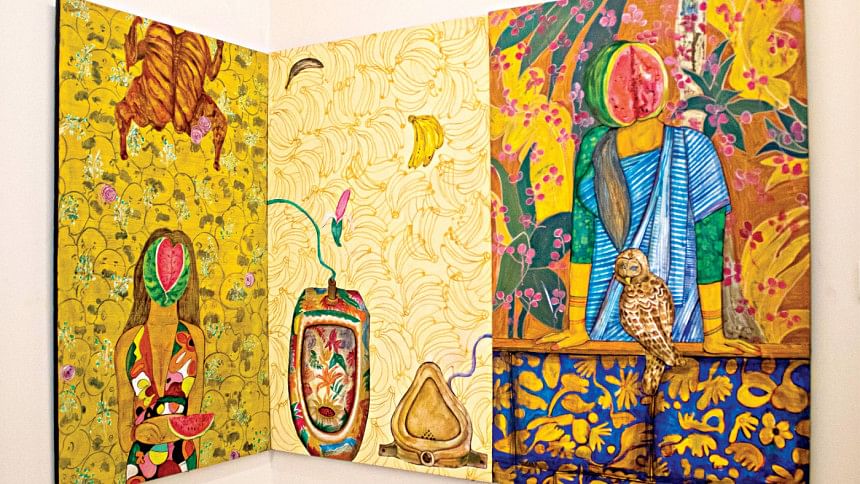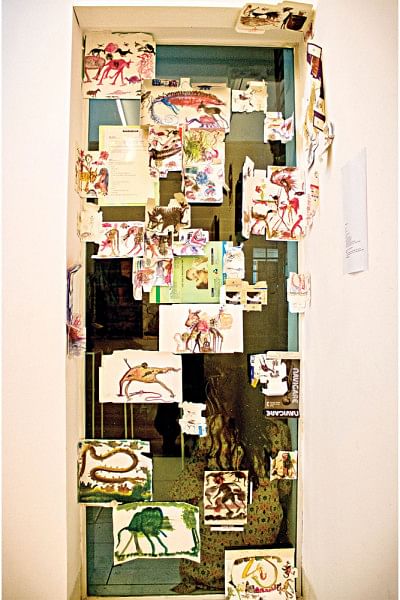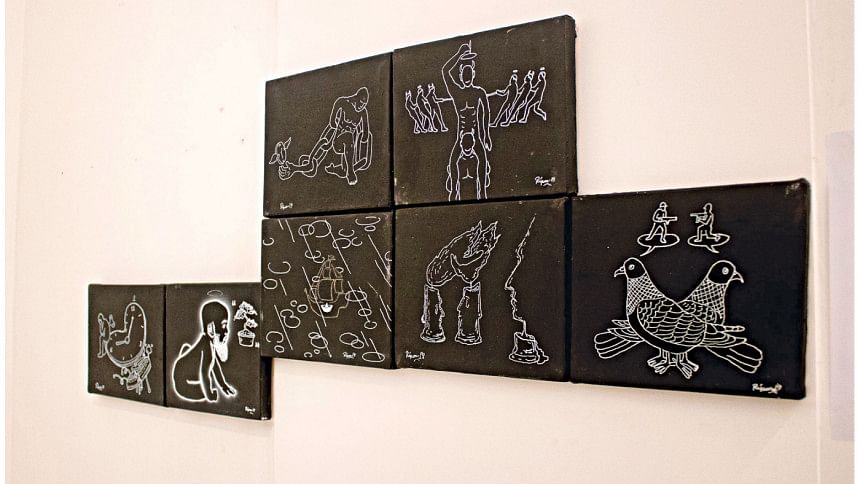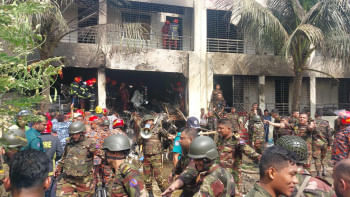Kala Kendra’s ‘Charcha. Charja. Uddojapon’ celebrates institutional art education of Chattogram

Celebrating 50 years of Bangladesh's independence and institutional art education in Chattogram, Kala Kendra's exhibition, "Charcha. Charja. Uddojapon" showcases the works of selected art graduates from Institute of Fine Arts, University of Chittagong.
The participating artists include Alok Kumar Sarkar, Afsana Sharmin, Abu Naser Robi, Ashraful Hasan, Yasmin Jahan Nupur, Emran Hosen, S M Reyad, Gonshai Pahlavi, Joydeb Roaja, Jayatu Chakma, Jasmin Akhter, Tanvir Parvez, Tasadduk Hossain Dulu, Dilara Begum Jolly, Niazzudin Ahmed Biju, Palah Bhattacharjee, Farah Naz Moon, Fahad Hasan Kazmee, Monir Mrittik, Mujahid Musa, Meherun Akter Sumi, Razib Dutta, Ripon Saha, Shatabdi Som, Sajib Sen, Sanjoy Bikash Das and Sanjib Dutta.
The diverse artworks on display celebrate the individuality of fine art practice in Chattogram. The artists have attempted to shed light on a variety of topics, including gender-based violence, socio-political issues, and the complexities of human nature. "We did not restrict the artists in terms of specific mediums and allowed them to be free with their creations," shared Wakilur Rahman, one of the curators of the show.

Emran's "Tousa" is a fascinating installation created with different food packages. "I completed this project during the pandemic. Since we could not purchase art supplies due to the lockdown, I started working with things available at home," he explained. The artworks featured represent the various moods, situations and uncertainty of this period.
On the other hand, Jolly's installation, "Deher Akkhyan'', was inspired by violence and abuse faced by women during the pandemic. It is a composition of soft sculptures, with materials such as worn out petticoats and blouses strained with intricate needlework, depicting the women's torture.
Tasadduk's "Celebration of Urbanisations" portrays the unhealthy competition binding our lives, as we often forget to differentiate between right and wrong. "Rural people are attracted to urbanisation, and this lifestyle poses a culture shock. In order to fit into this society, they sometimes indulge in various crimes," he said.
Alok created a sculpture with empty condensed milk cans entirely. Each can represents a human mind, enclosed within the boundaries of fear and resentment. The cans are all connected to each other, showing how human lives are intertwined despite being different.
Afsana's "An ignorant incidence", is based on industrialisation, corruption, and power politics. Through the project, she pays a tribute to the innocent lives lost in industrial accidents. The bones in her work denote the fossils of the workers, who are the foundation of an industrial society. "The workers' lives are neglected from all aspects. In this case, they were trapped in fire for hours without any sign of a fire extinguishing system. The lost lives also include those of children," she asserted.

Both Joydeb and Jayatu's works revolve around the lives of indigenous communities in the hill tracts. The social, political and cultural issues existing in these regions, along with the impact of development, are brilliantly portrayed through their pieces.
Jasmin's "Muhurto" consists of two self-portraits made with fabric. The work presents her reflections in different situations.
Lastly, Sanjoy's artwork depicts a traumatic chapter of his life as the artist lost his father, the day after his son was born. The work is a part of his ongoing series "My Notebook Page". He primarily used acrylic colours. He also added spray paint to provide texture, and represent his unique style.
The exhibition will be open for all till October 23, from 4 pm to 8 pm.
The author is a freelance journalist. Email: [email protected].

 For all latest news, follow The Daily Star's Google News channel.
For all latest news, follow The Daily Star's Google News channel. 



Comments